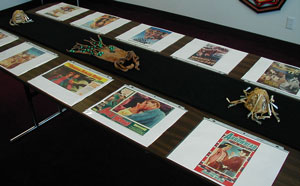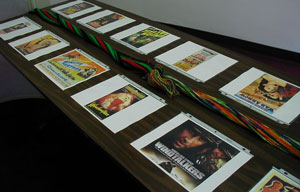|
|
Canku Ota |
|
|
(Many Paths) |
||
|
An Online Newsletter Celebrating Native America |
||
|
July 31, 2004 - Issue 118 |
||
|
|
||
|
Native American Exhibit Makes It's Mark In Hollywood |
||
|
by Priscilla Hwang SoCal Online |
||
|
So exactly how far have the American Indians come in Hollywood? According to Pond, not very far at all. "A lot of Indians are really angry about being portrayed as just savages and evil people," Pond said. We've all seen it cowboys in their leather chaps shooting away at the Indians with their bows and arrows. And we've certainly heard the word "savage" being used to describe the Indians once too many times. Pond's exhibit depicts exactly this, as dozens and dozens of movie posters out on display reveal white men chasing out the Indians. The wide range of posters puts on view Hollywood movies dating back from the 1930s up to the present. There is an undeniable theme running through films such as Tomahawk Territory (1952), Mohawk (1956), and Navajo Joe (1966). "All the Indians are white actors," Pond noted. "My parents never raised me to be racist, so we just had to look at it as actors playing natives," Pond continued saying while pointing out actors such as Charlton Heston and Pierce Brosnan, who have all played Indians in their careers at one point. "Film has been around for years and Hollywood still it has that image of us," Pond stated.
Roscoe Pond's exhibit will be open to the public until August 29, 2004. Visit his website at www.nativeroscoe.com |
|
|
||
|
|
||
| Canku Ota is a free Newsletter celebrating Native America, its traditions and accomplishments . We do not provide subscriber or visitor names to anyone. Some articles presented in Canku Ota may contain copyright material. We have received appropriate permissions for republishing any articles. Material appearing here is distributed without profit or monetary gain to those who have expressed an interest. This is in accordance with Title 17 U.S.C. Section 107. | ||
|
Canku Ota is a copyright © 2000, 2001, 2002, 2003, 2004 of Vicki Barry and Paul Barry. |
||
 |
 |
|
|
The "Canku Ota - A Newsletter Celebrating Native America" web site and its design is the |
||
|
Copyright © 1999, 2000, 2001, 2002, 2003, 2004 of Paul C. Barry. |
||
|
All Rights Reserved. |
||
 It's
a funny thing in Hollywood scores of actors have played the part
of American Indians in big budget films, and yet the real Indians
are hardly ever seen. Actor Roscoe Pond revealed to the public
the true Indians in the film industry in his new exhibit, "Natives
In Hollywood: How Far Have We Come?" this past weekend.
It's
a funny thing in Hollywood scores of actors have played the part
of American Indians in big budget films, and yet the real Indians
are hardly ever seen. Actor Roscoe Pond revealed to the public
the true Indians in the film industry in his new exhibit, "Natives
In Hollywood: How Far Have We Come?" this past weekend.
 Fortunately,
things started to take a brighter turn in 1990 when the movie Dances
With Wolves was released. According to Pond, Dances With Wolves
was the first to open the door for native Americans. "In the
nineties, things started coming to us to portray natives in a good
light," Pond said. As the story goes, a civil war veteran,
played by actor Kevin Costner, befriends a native tribe and sheds
his white-man's ways. Yet the true portrayal of native Americans
are not found in big name Hollywood films, rather, they are illustrated
in Independent films where celebrities such as Robert Redford have
supported and opened doors for native American independent film
makers. Native Americans make up only about 2 percent of the population,
and Pond notes that "we do not have a very big audience, but
it's growing through independent film." One of the most celebrated
independent film in their industry is Smoke Signals, released in
1998, which portrays natives as real people dealing with real life
issues. "Smoke Signals saw natives as normal and not just the
average savage or scalp hunters," Pond stated amusingly. Grand
Avenue, released in 1996 on HBO, is another independent film which
received rave reviews and placed number one on Pond's list. Grand
Avenue portrays a native American family living in an urban city
who deals with issues such as alcohol and murder. As Pond puts it,
"it depicts natives in modern society."
Fortunately,
things started to take a brighter turn in 1990 when the movie Dances
With Wolves was released. According to Pond, Dances With Wolves
was the first to open the door for native Americans. "In the
nineties, things started coming to us to portray natives in a good
light," Pond said. As the story goes, a civil war veteran,
played by actor Kevin Costner, befriends a native tribe and sheds
his white-man's ways. Yet the true portrayal of native Americans
are not found in big name Hollywood films, rather, they are illustrated
in Independent films where celebrities such as Robert Redford have
supported and opened doors for native American independent film
makers. Native Americans make up only about 2 percent of the population,
and Pond notes that "we do not have a very big audience, but
it's growing through independent film." One of the most celebrated
independent film in their industry is Smoke Signals, released in
1998, which portrays natives as real people dealing with real life
issues. "Smoke Signals saw natives as normal and not just the
average savage or scalp hunters," Pond stated amusingly. Grand
Avenue, released in 1996 on HBO, is another independent film which
received rave reviews and placed number one on Pond's list. Grand
Avenue portrays a native American family living in an urban city
who deals with issues such as alcohol and murder. As Pond puts it,
"it depicts natives in modern society." Pond's
exhibit truly captures the essence of Native Americans . His positive
energy penetrates deep into his work and his enthusiasm reminds
us that there is still light at the end of the tunnel. Hollywood
still has a long way to go, but it is only a matter of time before
Hollywood starts taking notice of all the talented native American
actors and filmmakers. Native Americans may have not come as far
as they wanted, but at this rate Hollywood better watch out because
soon they'll be the ones trying to catch up.
Pond's
exhibit truly captures the essence of Native Americans . His positive
energy penetrates deep into his work and his enthusiasm reminds
us that there is still light at the end of the tunnel. Hollywood
still has a long way to go, but it is only a matter of time before
Hollywood starts taking notice of all the talented native American
actors and filmmakers. Native Americans may have not come as far
as they wanted, but at this rate Hollywood better watch out because
soon they'll be the ones trying to catch up.